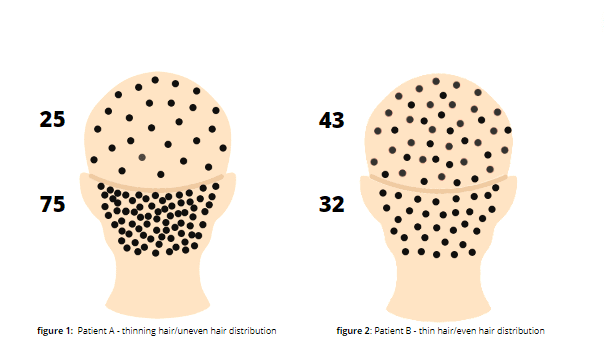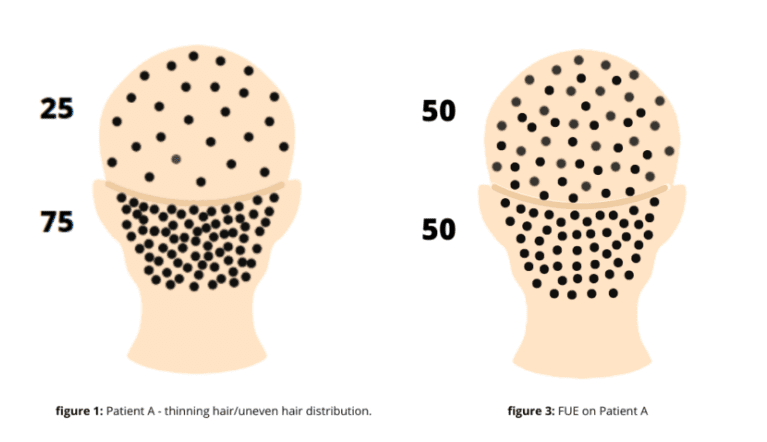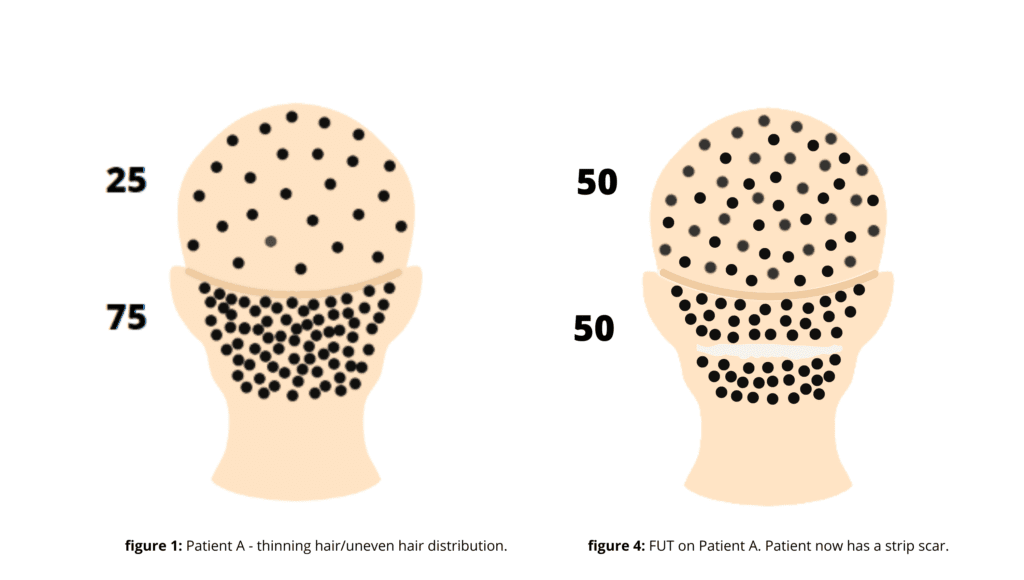Baldness is nothing new. Hair loss has been affecting the looks and self-esteem of many men and women since the beginning of time, and doctors and scientists have been trying to understand how and why for much of it. As much as this evolutionary phenomenon has been studied, we still have much to learn about its underlying mechanisms to understand better how to stop and reverse hair loss.
In the meantime, lucky for us, science is advanced enough to provide permanent solutions to hair loss. Hair transplantation is currently the permanent hair loss solution, and FUE is the most advanced and advantageous method. You can learn more about how an FUE hair transplant surgery works here, but in brief terms, it’s the extraction of hair grafts from one area of the head or the body and implanting those grafts into the balding area in the head. The solution to baldness is often, if not always, thought of in terms of numbers – the more hair you have, the less bald you are. This is applied to the transplanted hair the same way it’s applied to someone’s natural hair.
Shedding a New Light on What Makes Someone “Bald”
What if I told you the number of hair you have on your head is not the only factor qualifying you as bald or balding? In fact, it’s not even the most crucial factor. The appearance of baldness is at least as much about numbers as it is about contrast. Typically, when someone starts balding, they don’t lose hair throughout their head. Hair loss will start in one area – in men, often the hairline, the crown, or the temples. This thinning in some areas contrasts with the rest of the head, as hair loss is initially contained in those areas. This contrast signals baldness to an onlooker, even if the individual has thick hair in the unaffected areas and decent coverage left in the affected areas.
By way of illustration, let’s imagine we have two patients who could use more hair on their heads. We’ll call them Patient A and Patient B, and, to simplify the numbers, patient A has 100 hair follicles on his head, while Patient B has 75.
The distribution of Patient A’s hair is 25% on the top half of his head, and the rest (75%) is on the bottom half. Patient B has an even distribution of hair – all of his hair follicles are more or less evenly spread apart. When you look at Figure 1 and Figure 2 below, you’ll get a clearer idea of the hair distribution.
Looking at the illustration, you may notice how Patient A appears balder than Patient B. This is precisely because of the contrast in patient A’s head. The uneven distribution makes it evident he is losing hair at the top and may be quickly labeled “bald” despite having more hair than patient B, who, although has thin coverage, is relatively less likely to attract attention.

FUE as Solution to Contrast-Caused Bald Appearance
Just looking at a quick, simplified illustration like this one makes the role of contrast in the appearance of baldness apparent.


Although FUE is not the only hair transplant surgery, it’s the only way to reduce or eliminate contrast, so it’s the most effective way to achieve optimal hair restoration results. This is because, in FUT, the donor area is confined to a small strip on the back of the head. Excising grafts from one small area effectively reduces density in that area while leaving the remaining non-thinning area density the same.
To conceptualize this better, we can look at Patient A again. With the simplified numbers, he has 25 hairs on the top half of his head and 75 on the bottom.
After a FUT surgery, although he now has 50 hair on the top and 50 on the bottom, the overall hair density in the bottom half of his head hasn’t changed. The FUT practitioner has only derived the grafts from one sliver of his scalp. Meanwhile, the rest of his hair in the area is untouched. Indeed, the contrast between the top and bottom halves is now reduced since the density in the top was increased, so the patient will still see improvement in their coverage. However, an FUE practitioner would be able to do more for this patient by doing what was done in FUT – increasing density on the top and also by decreasing density on the bottom, in addition.
Why FUE Would Be the Better Solution
An FUE hair transplant surgery works by deriving individual grafts from anywhere on the head that has been deemed a safe zone, and those grafts are then implanted into the recipient area. Because the donor area is not restricted to a narrow strip, and the donor grafts come from a larger area, the hair density is reduced in the donor area instead of leaving it the same and creating a strip scar. If Patient A had undergone FUE surgery instead of FUT, he would have achieved more optimal results with the same number of grafts.
It is essential to understand the factors contributing to a bald appearance to understand the best hair transplantation method for achieving the most optimal results possible. This article should have given you a new perspective on what’s perceived as baldness – yes, the number of follicles on your head is the most apparent factor in it, but contrast is no less significant. Although when Body Hair Transplantation (BHT) is not employed, FUE and FUT do the same in terms of numbers, FUT cannot achieve contrast reduction to the extent FUE does.
How the Concept of Hair Restoration by Manipulating Contrast Expands Donor Supply
“A surgeon who judiciously utilizes this concept of game of contrast can uniformly extract more grafts from the entire back and sides of the scalp to yield much more grafts than a surgeon who does not understand this concept. The result is typically a much more complete restoration of bald and balding zones with a pristinely preserved donor area which does not look overharvested.” Dr U who is the pioneer of this concept explains. Dr U added further: “Couple this with our pioneering work that redefines the traditional concept of the safe donor area (SDA) as well as body hair transplantation (BHT), and you have the necessary ingredients and capability to take on the kinds of advanced hair loss and hair transplant repair cases my practice has become famous for.”
*FUE also allows for Body Hair Transplantation (BHT), exponentially expanding the donor pool.
You can see BHT surgery results here.


